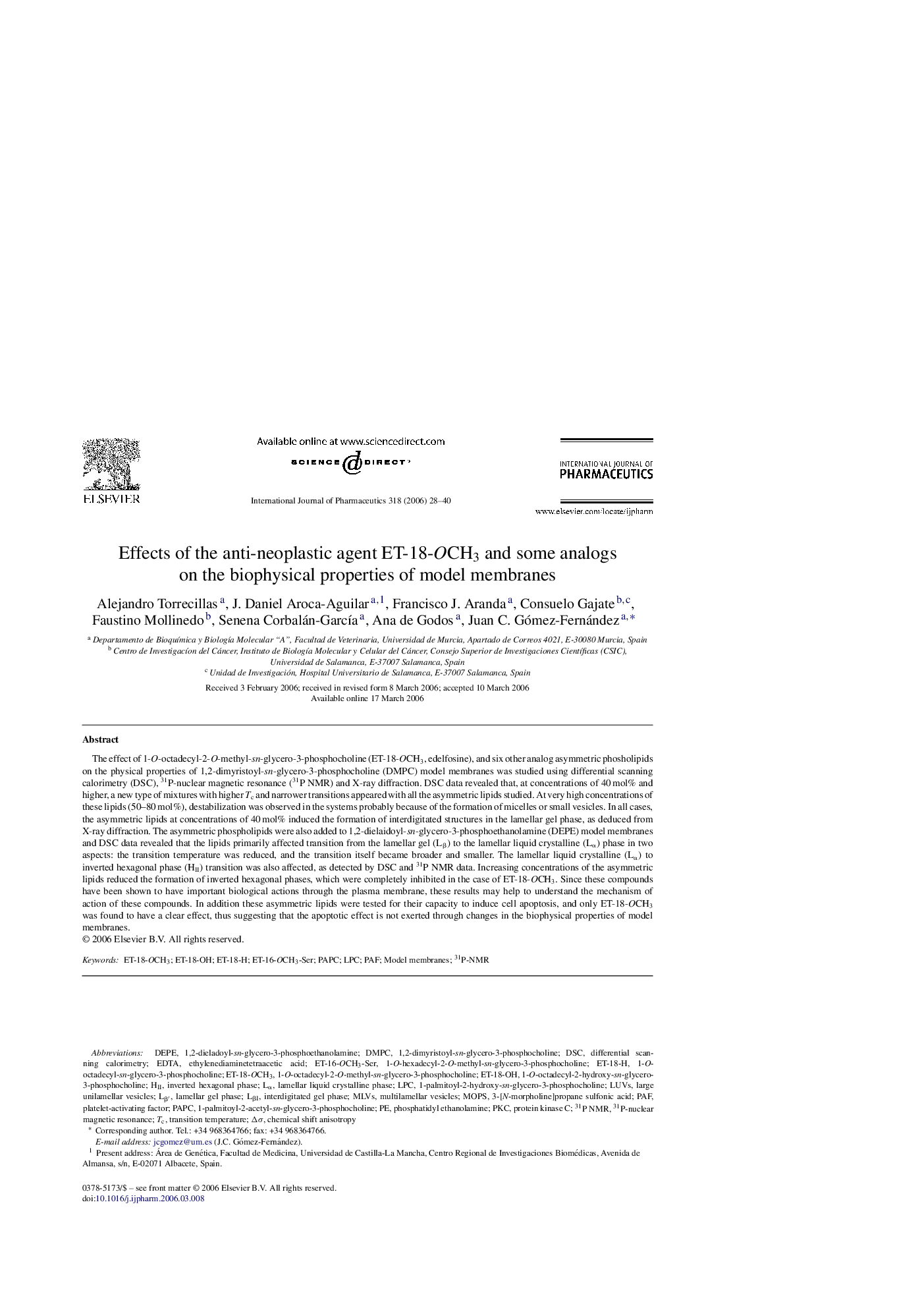| Article ID | Journal | Published Year | Pages | File Type |
|---|---|---|---|---|
| 2506838 | International Journal of Pharmaceutics | 2006 | 13 Pages |
Abstract
The effect of 1-O-octadecyl-2-O-methyl-sn-glycero-3-phosphocholine (ET-18-OCH3, edelfosine), and six other analog asymmetric phosholipids on the physical properties of 1,2-dimyristoyl-sn-glycero-3-phosphocholine (DMPC) model membranes was studied using differential scanning calorimetry (DSC), 31P-nuclear magnetic resonance (31P NMR) and X-ray diffraction. DSC data revealed that, at concentrations of 40 mol% and higher, a new type of mixtures with higher Tc and narrower transitions appeared with all the asymmetric lipids studied. At very high concentrations of these lipids (50-80 mol%), destabilization was observed in the systems probably because of the formation of micelles or small vesicles. In all cases, the asymmetric lipids at concentrations of 40 mol% induced the formation of interdigitated structures in the lamellar gel phase, as deduced from X-ray diffraction. The asymmetric phospholipids were also added to 1,2-dielaidoyl-sn-glycero-3-phosphoethanolamine (DEPE) model membranes and DSC data revealed that the lipids primarily affected transition from the lamellar gel (Lβ) to the lamellar liquid crystalline (Lα) phase in two aspects: the transition temperature was reduced, and the transition itself became broader and smaller. The lamellar liquid crystalline (Lα) to inverted hexagonal phase (HII) transition was also affected, as detected by DSC and 31P NMR data. Increasing concentrations of the asymmetric lipids reduced the formation of inverted hexagonal phases, which were completely inhibited in the case of ET-18-OCH3. Since these compounds have been shown to have important biological actions through the plasma membrane, these results may help to understand the mechanism of action of these compounds. In addition these asymmetric lipids were tested for their capacity to induce cell apoptosis, and only ET-18-OCH3 was found to have a clear effect, thus suggesting that the apoptotic effect is not exerted through changes in the biophysical properties of model membranes.
Keywords
MLVsinterdigitated gel phaseLβ′LβILα31P-NMRLUVsDEPEDSCMOPSPKCdMPCLPC31P NMR31P-nuclear magnetic resonance1-palmitoyl-2-hydroxy-sn-glycero-3-phosphocholine1,2-dimyristoyl-sn-glycero-3-phosphocholineChemical shift anisotropyET-18-OCH3PAPcmultilamellar vesiclesEDTAEthylenediaminetetraacetic acidHIIlarge unilamellar vesiclesTransition temperatureModel membranesLamellar liquid crystalline phaseInverted hexagonal phaselamellar gel phasePlatelet-activating factorphosphatidyl ethanolaminePAFProtein kinase CDifferential scanning calorimetry
Related Topics
Health Sciences
Pharmacology, Toxicology and Pharmaceutical Science
Pharmaceutical Science
Authors
Alejandro Torrecillas, J. Daniel Aroca-Aguilar, Francisco J. Aranda, Consuelo Gajate, Faustino Mollinedo, Senena Corbalán-GarcÃa, Ana de Godos, Juan C. Gómez-Fernández,
